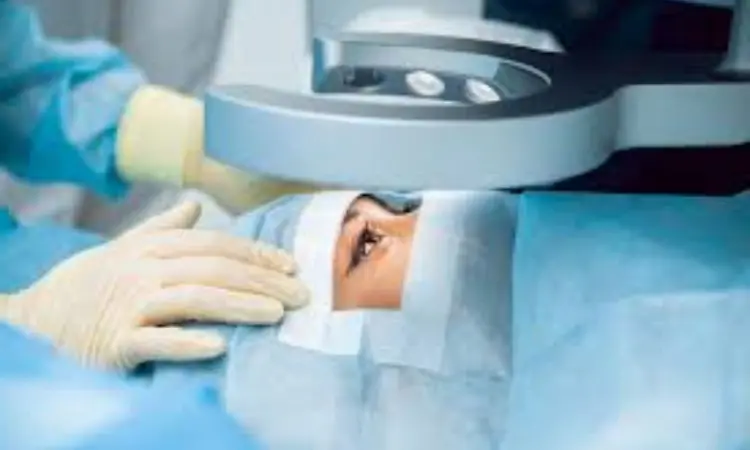- Home
- Medical news & Guidelines
- Anesthesiology
- Cardiology and CTVS
- Critical Care
- Dentistry
- Dermatology
- Diabetes and Endocrinology
- ENT
- Gastroenterology
- Medicine
- Nephrology
- Neurology
- Obstretics-Gynaecology
- Oncology
- Ophthalmology
- Orthopaedics
- Pediatrics-Neonatology
- Psychiatry
- Pulmonology
- Radiology
- Surgery
- Urology
- Laboratory Medicine
- Diet
- Nursing
- Paramedical
- Physiotherapy
- Health news
- Fact Check
- Bone Health Fact Check
- Brain Health Fact Check
- Cancer Related Fact Check
- Child Care Fact Check
- Dental and oral health fact check
- Diabetes and metabolic health fact check
- Diet and Nutrition Fact Check
- Eye and ENT Care Fact Check
- Fitness fact check
- Gut health fact check
- Heart health fact check
- Kidney health fact check
- Medical education fact check
- Men's health fact check
- Respiratory fact check
- Skin and hair care fact check
- Vaccine and Immunization fact check
- Women's health fact check
- AYUSH
- State News
- Andaman and Nicobar Islands
- Andhra Pradesh
- Arunachal Pradesh
- Assam
- Bihar
- Chandigarh
- Chattisgarh
- Dadra and Nagar Haveli
- Daman and Diu
- Delhi
- Goa
- Gujarat
- Haryana
- Himachal Pradesh
- Jammu & Kashmir
- Jharkhand
- Karnataka
- Kerala
- Ladakh
- Lakshadweep
- Madhya Pradesh
- Maharashtra
- Manipur
- Meghalaya
- Mizoram
- Nagaland
- Odisha
- Puducherry
- Punjab
- Rajasthan
- Sikkim
- Tamil Nadu
- Telangana
- Tripura
- Uttar Pradesh
- Uttrakhand
- West Bengal
- Medical Education
- Industry
Low-Level Light Therapy Improves dry eye symptoms among patients undergoing Cataract Surgery

Cataract Surgery
Optimizing the ocular surface prior to cataract surgery has been highlighted in recent studies, especially for individuals who already have dry eye disease (DED). Nevertheless, a recent study published in British Journal of Ophthalmology indicates that even healthy patients having cataract surgery may benefit from low-level light therapy (LLLT) as a prophylactic measure.
Researchers have found in a new study that two sessions of low-level light therapy before and after cataract surgery were effective in ameliorating tear film stability and ocular discomfort symptoms.
LLLT or a sham therapy was randomly assigned to 153 individuals in this double-masked research. The sessions took place both before and after cataract surgery. The Ocular Surface Disease Index (OSDI) questionnaire, non-invasive break-up time (NIBUT), tear meniscus height, meibomian gland loss (MGL), and redness score were among the outcomes measured by the trial thirty days after surgery.
Patients who received LLLT demonstrated significantly lower OSDI scores at two different postoperative time points, indicating reduced ocular discomfort compared to the control group. Additionally, NIBUT values were higher among the LLLT-treated patients at the second assessment, suggesting improved tear film stability. Meibomian gland loss, which is often associated with DED, was also lower in the LLLT group at the first postoperative assessment.
Importantly, the benefits of LLLT were not limited to the postoperative period; patients who received this treatment continued to experience lower OSDI scores and higher NIBUT values at the final assessment compared to their preoperative scores.
This research provides a ray of hope for individuals undergoing cataract surgery. The findings suggest that preventive measures, such as LLLT, can enhance patient comfort and ocular health during and after the surgery, even for those without pre-existing dry eye disease. With cataract surgery being one of the most commonly performed procedures globally, any intervention that can improve patient outcomes and comfort is of significant clinical interest.
While further studies are needed to confirm these findings and establish the long-term effects of LLLT, this research marks a notable step forward in enhancing cataract surgery and postoperative care. It could potentially lead to a broader adoption of LLLT as a routine prophylactic measure for individuals undergoing this common and transformative surgical procedure.
Reference:
Giannaccare, G., Rossi, C., Borselli, M., Carnovale Scalzo, G., Scalia, G., Pietropaolo, R., Fratto, B., Pellegrini, M., Yu, A. C., & Scorcia, V. (2023). Outcomes of low-level light therapy before and after cataract surgery for the prophylaxis of postoperative dry eye: a prospective randomised double-masked controlled clinical trial. In British Journal of Ophthalmology (p. bjo-2023-323920). BMJ. https://doi.org/10.1136/bjo-2023-323920
Dr Ishan Kataria has done his MBBS from Medical College Bijapur and MS in Ophthalmology from Dr Vasant Rao Pawar Medical College, Nasik. Post completing MD, he pursuid Anterior Segment Fellowship from Sankara Eye Hospital and worked as a competent phaco and anterior segment consultant surgeon in a trust hospital in Bathinda for 2 years.He is currently pursuing Fellowship in Vitreo-Retina at Dr Sohan Singh Eye hospital Amritsar and is actively involved in various research activities under the guidance of the faculty.
Dr Kamal Kant Kohli-MBBS, DTCD- a chest specialist with more than 30 years of practice and a flair for writing clinical articles, Dr Kamal Kant Kohli joined Medical Dialogues as a Chief Editor of Medical News. Besides writing articles, as an editor, he proofreads and verifies all the medical content published on Medical Dialogues including those coming from journals, studies,medical conferences,guidelines etc. Email: drkohli@medicaldialogues.in. Contact no. 011-43720751


